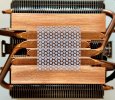Just my .02$ - I was never a fan of spreading. Too easy to get small air bubbles captured. I usually just put one dab about the size of a grain of rice and clamp the heatsink. On most boards you can see that it flowed to the edge of the cpu die after the heatsink was clamped. I do remember using the "X" method on larger dies (AMD?). Still, no more than a couple grains of rice. Thermal compound flows pretty well especially after getting hot. The idea is less, not more (which is why I never liked the thermal pads). ...and in earlier days not all compounds were non-conductive like they are today so you had to be very vigilant about overflows....
[SOLVED] How's my CPU thermal paste application?
- Thread starter Appletax
- Start date

